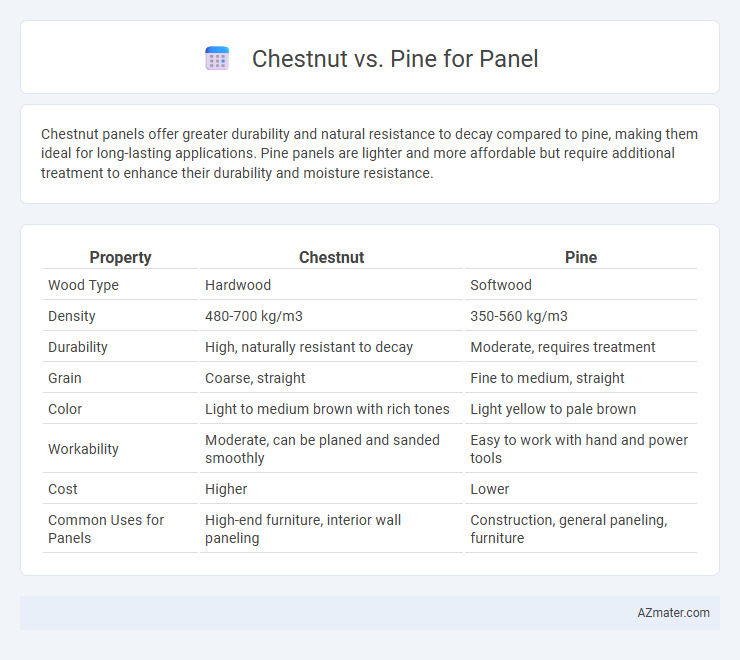Chestnut panels offer greater durability and natural resistance to decay compared to pine, making them ideal for long-lasting applications. Pine panels are lighter and more affordable but require additional treatment to enhance their durability and moisture resistance.
Table of Comparison
| Property | Chestnut | Pine |
|---|---|---|
| Wood Type | Hardwood | Softwood |
| Density | 480-700 kg/m3 | 350-560 kg/m3 |
| Durability | High, naturally resistant to decay | Moderate, requires treatment |
| Grain | Coarse, straight | Fine to medium, straight |
| Color | Light to medium brown with rich tones | Light yellow to pale brown |
| Workability | Moderate, can be planed and sanded smoothly | Easy to work with hand and power tools |
| Cost | Higher | Lower |
| Common Uses for Panels | High-end furniture, interior wall paneling | Construction, general paneling, furniture |
Introduction to Chestnut and Pine Wood
Chestnut wood is known for its durability, fine grain, and natural resistance to decay, making it an excellent choice for interior and exterior paneling. Pine wood is a softer, more affordable option with a light color and prominent knots, commonly used in paneling for its ease of staining and versatility. Both woods offer distinct aesthetic and functional qualities, with chestnut favored for longevity and pine preferred for cost-effectiveness and ease of customization.
Origins and Growth Characteristics
Chestnut wood originates primarily from temperate regions of the Northern Hemisphere, especially Europe, Asia, and eastern North America, known for its dense grain and natural resistance to decay. Pine, native to the Northern Hemisphere's cooler regions, grows faster than chestnut, featuring a lighter, softer texture with more prominent knots and resin canals. Chestnut panels provide enhanced durability and rich warm tones, while pine panels offer affordability and ease of handling due to their rapid growth and lighter weight.
Appearance and Grain Patterns
Chestnut wood displays a rich, warm brown hue with prominent grain patterns that feature bold, sweeping arcs and occasional knots, creating a rustic yet elegant aesthetic. Pine offers a lighter, creamy-yellow tone with more uniform, straight grain lines and frequent knots that impart a casual, country-style charm. The choice between chestnut's dramatic grains and pine's subtle simplicity significantly influences the visual impact of interior paneling.
Durability and Longevity
Chestnut wood offers superior durability and resistance to decay compared to pine, making it ideal for long-lasting panel installations. Pine, while more affordable and easier to work with, is softer and more prone to dents and moisture damage over time. For panels requiring extended longevity and robust structural performance, chestnut is a more reliable choice.
Workability and Ease of Installation
Chestnut wood offers superior workability for paneling due to its fine grain and moderate hardness, making it easier to cut, shape, and finish with hand or power tools. Pine, being a softer wood, allows for quick and straightforward installation, especially when using nails or screws, but it may dent or scratch more easily during handling. Both woods provide efficient installation, with chestnut favored for detailed craftsmanship and pine preferred for faster, budget-friendly projects.
Cost Comparison
Chestnut panels typically cost more than pine due to their durability and rich appearance, averaging between $8 to $12 per square foot compared to pine's $3 to $7 per square foot. Pine is more affordable, making it ideal for budget-conscious projects, but it may require more maintenance over time due to its softer wood. The higher initial investment in chestnut is often justified by its longevity and resistance to wear, potentially reducing long-term replacement costs.
Environmental Impact and Sustainability
Chestnut wood, sourced from renewable forests, offers high sustainability due to its fast growth and natural resistance to pests, reducing the need for harmful chemical treatments. Pine, also widely available, has a lower environmental impact when harvested responsibly, but it typically requires more frequent treatment with preservatives to prevent decay. Choosing chestnut for paneling promotes eco-friendly practices by extending product lifespan and minimizing chemical use, whereas pine demands careful forest management to maintain its sustainability credentials.
Common Uses in Paneling
Chestnut wood is prized in paneling for its rich color and durability, making it ideal for decorative interior walls and traditional architectural features. Pine, known for its light color and affordability, is commonly used in casual or rustic paneling applications, such as cabins, cottages, and interior accent walls. Both woods offer distinct aesthetics and functional benefits, with chestnut suited for high-end finishes and pine favored for budget-friendly, versatile projects.
Maintenance and Care Requirements
Chestnut panels require moderate maintenance, including periodic sealing and cleaning to prevent moisture damage and preserve their rich color. Pine panels demand more frequent upkeep due to their softer nature, needing regular sanding, sealing, and protection from dents and scratches. Both woods benefit from controlled indoor humidity to extend their lifespan and maintain panel integrity.
Choosing the Right Wood for Your Panels
Chestnut offers a rich, warm tone and natural durability, making it ideal for decorative panels that require longevity and an elegant finish. Pine provides a lighter, softer wood with a more cost-effective price point, suitable for budget-friendly projects and easier customization through staining or painting. Selecting between chestnut and pine depends on balancing aesthetic goals, durability needs, and budget constraints for your paneling project.

Infographic: Chestnut vs Pine for Panel
 azmater.com
azmater.com